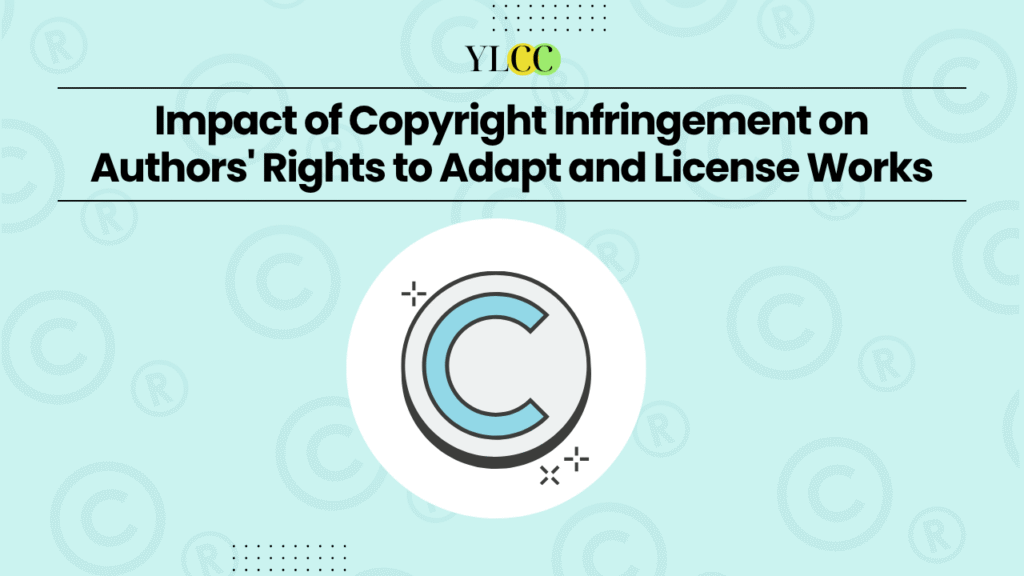
Introduction to Concept:
Copyright refers to the legal rights that creators have over their artistic and creative work, which includes a range from books, music, paintings, sculpture, and films, to computer programs, databases, advertisements, maps and technical drawings.[1] There are two broad categories of rights under copyright: economic rights and moral rights.
The economic right entails the right to receive remunerations and to authorize or prohibit certain usage of a work. In comparison, the moral right emphasizes over the right to claim authorship and to oppose alteration to the work that may harm the author’s reputation.
Any strict and rigid restriction on licensing leads to constraints on the consequent economic activity. Parallely any loophole in the aptness of needful restriction leads to uncontrollable infringement based on adaptation, licensing etc. Both ways it has one or the other impact on the Author.
What is Copyright Infringement?
The Copyright Act of 1957 specifies what constitutes copyright infringement under Section 51 of the act.[2]As per judicial interpretations, Copyright is considered infringed only if a substantial part is used without authority. However, what is ‘substantial’ varies from case to case. “Substantial part” is recognized based on quality more than quantity. For illustrations, if a lyricist copies a very catching phrase from another lyricist’s song, there is likely to be infringement even if that phrase is very short. The Hon’ble Courts have time and again established vivid tests to ascertain copyright infringement in this dynamic world of technological development and continuous innovation. Two major tests in this aspect are:
- The Substantial Similarity Test: In the landmark Judgment of R.G. Anand v. Delux Film[3] case, the Hon’ble Apex Court noted that the origin of work being common may give rise to similarities but the way of expression must be distinguished. The court, thus, brought forward the Pattern test, Abstraction-Filtration-Comparison Test, and Total Concept & Feel Test to determine what is substantial on a case-to-case basis. The US Supreme Court had also held in Meshwerks Case[4]that merely transferring work from one medium to another, without the addition of input, is a mere reproduction (and hence infringement) of the copyrighted expression in the original.[5]
- The Lay Observer’s Test: Also referred to as ‘The Audience Test’. Herein, if the audience (that is any person with a reasonable mind) finds substantial similarity in the defendant’s expression of an idea, then there is copyright infringement.
Uncontrolled adaptation and licensing
Adaptation[6]in its connotation implies innocence and a mere attempt to gain inspiration from an existing act. Licensing allows legitimacy and approval to an act which in absentia would lead to infringement.[7]
Licensing and Adaptation, thus, formulate a delicate balance between fulfilling the interest of the author’s rights and the effective utilization of the work. Its holistic framework ensures that authors and artists get paid for their work and it authorizes creative works to be shared, dispelled, exchanged, and circulated; hence reducing chances of people being exploited as they contribute to society’s growth, hymning, and learning.[8]
Some key impacts of unauthorized usage on the Author’s right to adaptation and licensing are:
- Loss of Authority & Control over Derivative Usage
- Reputational Damage
- Market Devaluation
- Diminishing Market Growth
- Shrink in Licensing potential
Remedies to infringements/financial losses
There exists a bunch of remedies that can be taken to recover the loss of money as well as repute due to copyright infringement. These remedies can be broadly bifurcated as civil remedies and criminal remedies based on their nature. It is to be noted here that both civil and criminal remedies are complementary to each other and not alternatives.[9]
Civil Remedies:
Section 55 of the Copyright Act provides for three civil remedies, namely –
- Injunction: Injunction[10] refers to a judicial process which is considered plain, complete, practical and efficient remedy to meet ends of justice.[11] In Injunction, a stay is put forth on an infringer’s act or omission that has caused a violation of rights of the owner/author. Injunction aims to stop further violation of the copyright rather than to seek compensation for the plaintiff.
- Damages: Damages refer to the determination of the sum which the defendant (infringer) must pay to the plaintiff to make the loss good. Damages can be simply understood as compensation provided to the copyright owner. The purpose of ordering to provide the damages to the copyright holder is to restore the owner to the earlier position.
Damages are not always co-terminus with ‘Actual Damage’ as damages also include:
Nominal Damages: A small amount of money to be paid when no actual financial loss occurred but suffered legal damages.
Punitive/Exemplary Damage: Additional damages laid on the defendant beyond the actual losses suffered by the plaintiff to punish the defendant for its egregious & malicious conduct. It is awarded with the intent to set a deterrence effect.
The Delhi High Court in Strix case noted that damages are of three kinds i.e., notional damages, compensatory damages, and punitive damages. The Court held that in a case where the evidence is not led, the damages have to be notional and are to be considered on a reasonable/fair basis. In such a case, the Court can only make a broad assessment of profits, based on the evidence on record.[12]
- Accounts: Accounts refer to the payment of the sum of money to the plaintiff which the defendant unduly gained in the period of infringement. This closely resonates with the concept of Mesne Profits.
The proviso in Sec 55 of the Copyright Act, 1957 states that wherein the Defendant proves that at the date of infringement, he was neither aware nor had reasonable grounds to believe the subsistence of copyright, he would not be decreed to any remedy other than injunction & an amount equivalent to the profit gained by such copyright infringement.
Criminal Remedies:
The Copyright Act, 1957 recognizes the copyright infringement as a criminal act.[13]When a person knowingly infringes or abets the infringing act of a copyrighted work, then the offence is a criminal offence under the Copyright Act, 1957. The minimum punishment for the first-time offender who commits or abets copyright infringement is imprisonment for six months, which can extend to three years, with a minimum fine of Rs. 50,000, extendable up to Rs.2 lakhs.
In the case of a subsequent and second conviction, the punishment is imprisonment for a minimum of one year, extendable to three years and a fine of Rs.1 lakhs, extendable to Rs.2 lakhs.
Only in cases wherein the infringement is proved not to be committed for gains in trade and business, this punishment and fine limits can be reduced further with reasons to be specified in judgment.
Any police officer (not below the sub-inspector rank) can seize the infringing copies without a warrant when the police officer is satisfied that a copyright infringement offence in any work has been committed and produce them before the Magistrate.[14]
Conclusion:
Considering the high stakes of the rights of authors, whether it be creative or monetary rights, due to infringement, it is essential to bring awareness about the available remedies to the public at large. The knowledge of recourse shall act as a boon to victim authors and as a deterrent for the infringers.
[1] WIPO, https://www.wipo.int/en/web/copyright (last visited Feb. 20, 2025).
[2] The Copyright Act, 1957, §. 51, No. 14, Acts of Parliament, 1957 (India).
[3]R.G. Anand v. M/S Delux Film &Ors., 1978 AIR 1613.
[4]Meshwerks v. Toyota, 528 F.3d 1258 (10th Cir. 2008).
[5]Brian D. Wassam, Augmented Reality Law, Privacy, and Ethics 101-151 (2015).
[6] The Copyright Act, 1957, §. 14(a)(vi), No. 14, Acts of Parliament, 1957 (India).
[7] The Copyright Act, 1957, §. 30, No. 14, Acts of Parliament, 1957 (India).
[8]Dipanshu Raj and Utkarsh Ajmera, Protecting Creativity: A Look at Copyright Law and Licensing in India, MANUPATRA (Feb. 20, 2025, 7:58 PM) https://articles.manupatra.com/article-details/Protecting-Creativity-A-Look-at-Copyright-Law-and-Licensing-in-India.
[9]Ministry of Commerce and Industry, A Handbook of Copyright Law (Department for Promotion of Industry and Internal Trade) https://copyright.gov.in/Documents/handbook.html.
[10] HENRY CAMPBELL BLACK, THE BLACK’S LAW DICTIONARY 40 (West Publishing Co., 1990).
[11] Hancock v. Bradshaw Tex.Civ. App., 350 S.W. 955, 957.
[12] Strix Ltd. v. Maharaja Appliances Ltd. 2023 SCC Online Del 7128.
[13] The Copyright Act, 1957, §§. 63-63A, No. 14, Acts of Parliament, 1957 (India).
[14]The Copyright Act, 1957, §. 64, No. 14, Acts of Parliament, 1957 (India).
This article has been written by Astha. For any other queries, reach out to us at: queries.ylcc@gmail.com






